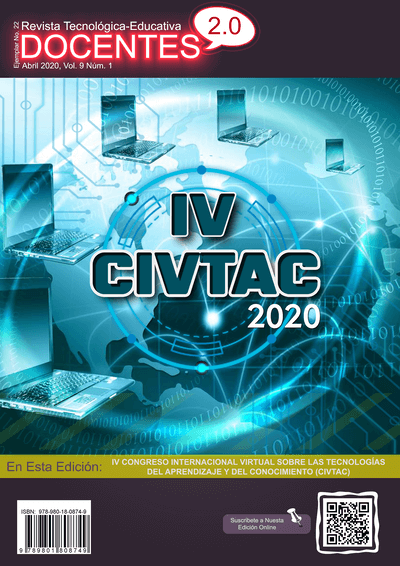ICT as an opportunity to strengthen the EAP in students with visual disabilities
 DOI:
https://doi.org/10.37843/rted.v9i1.97
DOI:
https://doi.org/10.37843/rted.v9i1.97
Main Article Content
Abstract
This article is based on the influence of Information and Communication Technology to strengthen the Teaching and Learning Process in students that have visual impairment. The research is based on the bases of Downes and Siemens' connectivism allowing to articulate new forms of knowledge; blind people confront many challenges day by day to get by on their own, from the inadequate physical space for their transport, as well as in the development of activities in education, that is why we try to describe the contributions that the new technologies that exist in the environment provide and the benefits that they generate in the teaching and learning process of people with this type of disability. The methodology that was used corresponded to a qualitative approach of documentary focus, as well as the application of an interview for the process of data collection. The results obtained showed that the existence of a variety of computer resources, such as Talkback, Nvda, Vocalizer, Jaws, would allow the student's independence in the learning process, generating a level of autonomy to enhance their cognitive development. Finally, it can be stated that the insertion of ICT in the processes of educational inclusion allows to reduce the barriers that are presented in the development of the formation of the teachers, managing to apply inclusive activities with the use of technology in the development of the class, understanding that there is a diverse society with different ways of thinking, learning and acting.
Downloads
Metrics
Article Details

This work is licensed under a Creative Commons Attribution-NonCommercial-NoDerivatives 4.0 International License.
Those authors who have publications in our journal accept the following terms:
- When a work is accepted for publication, the author retains rights of reproduction, distribution of his/her article for exploitation in all countries of the world in the format provided by our magazine and any other magnetic medium, optical, and digital.
- Authors will retain their copyright and guarantee the journal the right first to publish their work, which will be simultaneously subject to the Creative Commons Acknowledgment License (Attribution-NonCommercial-NoDerivatives 4.0 International (CC BY-NC-ND 4.0)). That allows third parties to copy and redistribute the material in any medium or format, under the following conditions: Acknowledgment - You must properly acknowledge authorship, provide a link to the license, and indicate if any changes have been made. You may do so in any reasonable way, but not in a way that suggests you have the licensor's endorsement or receive it for your use. NonCommercial - You may not use the material for a commercial purpose. NoDerivatives - If you remix, transform, or build from the material, you cannot broadcast the modified material. There are no additional restrictions - You cannot apply legal terms or technological measures that legally restrict you from doing what the license allows.
- Authors may adopt other non-exclusive license agreements to distribute the published version of the work (e.g., deposit it in an institutional archive or publish it in a monographic volume) provided that the initial publication in this journal is indicated.
- Authors are allowed and recommended to disseminate their work through the Internet (e.g., in institutional telematic archives, repositories, libraries, or their website), producing exciting exchanges and increasing the published work's citations.
- Request of withdrawal an article has to be done in writing by the author to the Editor, becoming effective after a written response from the Editor. For this purpose, the author or authors will send correspondence via e-mail: [email protected].
- The author will not receive financial compensation for the publication of his work.
- All Docentes 2.0 Journal publications are under the Open Journal System (OJS) platform at: https://ojs.docentes20.com/.
References
Álvarez, F., Benítez, E., Esparza, A. & Margain, L. (2018). Desarrollo y evaluación de un sistema interactivo para personas con discapacidad visual. TecnoLógicas, 21(41), 149-157. http://www.scielo.org.co/pdf/teclo/v21n41/v21n41a10.pdf
CIE.9.MC (2014). Clasificación Internacional de Enfermedades. 9.a edición. http://bit.ly/3aJ5sQD
Collado, S. & Giménez, J. A. (2017). Tiflotecnología. https://web.ua.es/es/cae/documentos/noticias/2017/tiflotecnologia-para-deficit-visual-once-juan-antonio-gimenez-sonia-collado.pdf
CONADIS. (2020). Estadísticas de Discapacidad – Consejo Nacional para la Igualdad de Discapacidades. https://www.consejodiscapacidades.gob.ec/estadisticas-de-discapacidad/
Gross, M. (2014). Prácticas inclusivas para la población estudiantil en condición de discapacidad visual en el entorno universitario. Alteridad. Revista de Educación, 9(2), 108-117.
Defez, B., Dunai, L., Lengua, I. & Peris, G. (2013). Dispositivo de navegación para personas invidentes basado en la tecnología Time Of Flight. DYNA, 80(179), 33-41, https://revistas.unal.edu.co/index.php/dyna/article/view/35788
Lee, L. & Watts M. (2017). Las TIC como herramientas de inclusión educativa. Acta ScientiÆ InformaticÆ, 1(1), 92-97. https://revistas.unicordoba.edu.co/index.php/asinf/article/view/1167
Martínez, V., Sandoval, M. & Zúñiga, S. (2014). Tiflotecnología y educación a distancia: propuesta para apoyar la inclusión de estudiantes universitarios con discapacidad visual en asignaturas en línea. Nueva Época, 6(1), 1-21. http://bit.ly/2vYDbqn
OMS. (2018). Ceguera y discapacidad visual. https://www.who.int/es/news-room/fact-sheets/detail/blindness-and-visual-impairment
UNDP. (s.f.). Objetivo 4: Educación de calidad | PNUD. https://www.undp.org/content/undp/es/home/sustainable-development-goals/goal-4-quality-education.html






